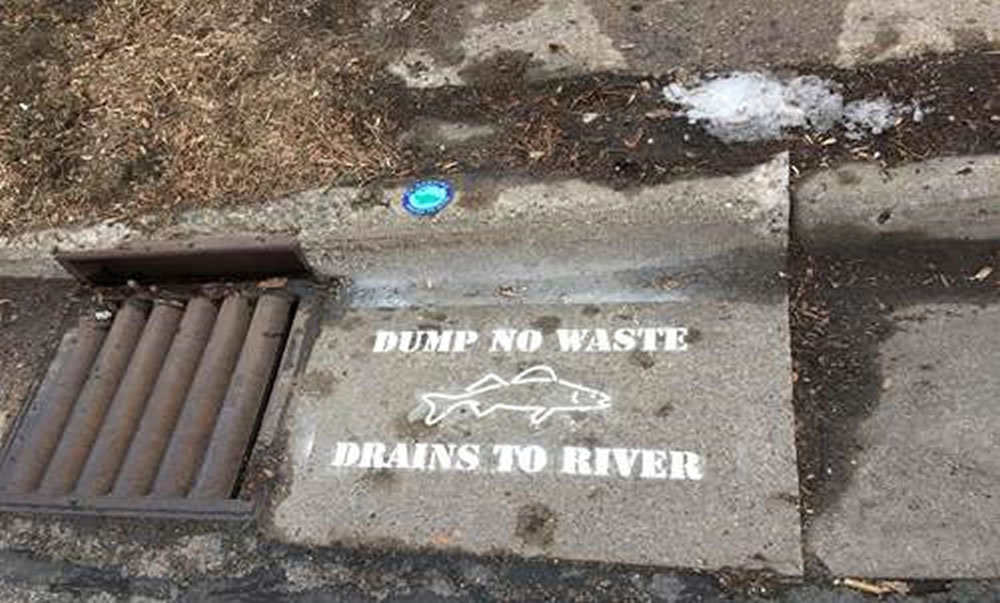Master Water Stewards stormwater project hits close to home

By Dayna Ball, Communications Intern
Raised near the Mississippi River, Tessa Anttila has always had a great appreciation for water. Because of her Native American roots, she felt protective of the natural resource growing up. When she moved to Minneapolis as an adult, Anttila wondered how she could carry her appreciation for water over to an urban setting. She started looking for ways to get involved with local water issues and came across the MWMO.
Similarly, Rachel Johnson, another resident of the watershed, was searching for a way to be more involved in her community. She wanted to develop a skill she could share with people in her neighborhood and use to connect with local organizations and schools.
The two turned their aspirations into action last fall and joined the MWMO’s second class of Master Water Stewards. Started by the Freshwater Society in 2013, the Master Water Stewards program trains community members to be leaders and advocates for clean water in their own neighborhoods.
This year’s MWMO class of 17 individuals learned about stormwater best management practices (BMPs), hydrology, water policy and community engagement. At the end of the program, each member completes a capstone project that reflects what they’ve learned throughout the training and improves stormwater management in their community. The capstone includes a both physical BMP project and a community education component.
Anttila didn’t have to look far to find an exciting capstone project. She wanted to collaborate with her son’s school, New City Charter School in Northeast Minneapolis. She asked her fellow Master Water Stewards trainees whether any of them might be interested in developing a curriculum and co-teaching a class. Johnson, who has a background in environmental education, jumped at the opportunity.
Last winter, Anttila and Johnson partnered with the school to offer an elective class for elementary students every Friday for four weeks. In the hands-on course, students learned the basics about watersheds, stormwater runoff and what they could do to prevent river pollution.

On the last day of the class, the students adopted a storm drain near their school. They swept leaves, grass clippings and trash away from the drain and did their part in reducing the amount of pollutants that flow into storm drains and, subsequently, the river.
Students also added stencils and icons to the storm drain that say, “Dump No Waste, Drains to River.” In the upcoming years, a team of students and parents at New City Charter School will continue to keep the drains clean of debris and pollutants.
“The students were excited and engaged participants, eager to learn and take action at their campus,”
Johnson said.
The pair then turned their attention to the physical portion of their capstone, once again finding a suitable project close to home.
Anttila’s Northeast Minneapolis residence suffered from drainage problems, as did her neighbor’s property. Stormwater runoff pooled in Anttila’s driveway and flooded her basement on occasion. To address this issue, Anttila and Johnson decided to replace the run-down concrete driveway with permeable pavers, which would allow stormwater to soak in between the bricks and infiltrate into the ground. Although permeable pavers can be one of the more pricey BMP options, they are highly effective in absorbing and filtering stormwater — and also make for a very attractive driveway.

In addition to revamping the driveway, the pair built a rain garden in Anttila’s front yard to address stormwater runoff from her porch roof. They also planted additional native plants alongside the driveway to soak up stormwater runoff from her neighbor’s roof.
With graduation from the program just a few months away, Johnson says her experience has made her a better communicator about water issues.
“Trying to explain the program to family and friends has started conversations about how we handle stormwater at a small scale,” she said.
Reflecting on the experience, Anttila felt very inspired by her fellow Master Water Stewards classmates’ investment and dedication to clean water in their communities.
“It’s been really great to see how other people are involved and how hard they have been working for years at this,” Anttila said.
While executing a project like this might seem intimidating, Johnson wants others to know it’s within reach. “Building a rain garden is really possible; the biggest thing we needed was people power,” she said. “We had some friends and fellow Master Water Stewards classmates come help, and it was completely doable.”

Stormwater management and water pollution in general can be daunting problems to tackle, but the more people work together, the more manageable the task becomes. Joining the Master Water Stewards program is just one way you can make a positive impact in our watershed community. You can also use our website to find out more about what you can do to reduce runoff pollution in the Mississippi River.
If you’re interested in becoming a Master Water Steward yourself, be on the lookout for updates about on the class of 2017-2018 on the Master Water Stewards website.








